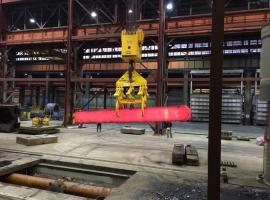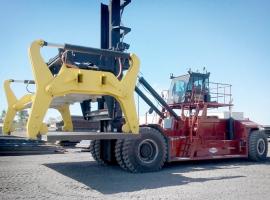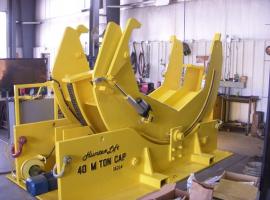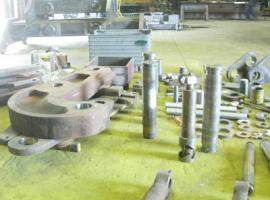Unlike the crane material handling equipment itself, which has very specific inspection standards, in general, it appears that there are no inspection standards or criteria for below-the-hook lifting devices in the OSHA regulations. However, with regard to whether OSHA recognizes ANSI/ASME B30.20 specifications as the reference point for determining inspections for Below-the-Hook Lifting Devices, the answer is yes. OSHA refers to the subject consensus standard for inspection provisions for Below-the-Hook Lifting Devices.
OSHA does however reference lift inspection recommendations covering a variety of topics. For example, whether the attachment is a structural lifter (with a static, rigid structure that includes 2- or 4-point lifting beams, C-hooks, and pallet lifters), or a mechanical lifter powered manually, electrically, pneumatically, or hydraulically to securely attach to the load, it is important that the equipment operator is properly trained on each specific lift they operate. In addition, OSHA recommends following the specific inspection instructions offered by the lift equipment manufacturer for both standard and custom engineered designs that match the specific requirements or features of the load the device is intended to lift.
At Hunter Lift, we provide our customers with very specific inspection and maintenance instructions for every lift device we manufacturer. Additionally, owners of below-the-hook lifting devices have a variety of responsibilities that are critical to the safe operation of this equipment. That’s why the members of the Crane Manufacturers Association of America (CMAA) recently published CMAA Specification 80 – Below-The-Hook Lifting Device Operator’s Manual. The document is recommended for use as a complement to CMAA Specification 79 – Crane Operator’s Manual, as well as in conjunction with the operating instructions and maintenance manuals provided by the equipment manufacturer(s). We highly recommend obtaining a copy of this manual and following their recommendations.
Over the years, we have gathered many do’s and don’ts when it comes to device inspection, maintenance and operation. Following these recommendations will enhance both the integrity and reliability of the equipment, as well as reduce the risk of injury for workers as they operate the attachment or work in proximity to it.
Below-The-Hook Equipment Do’s:
- Carefully read any and all documentation provided by lifting device manufacturer which could include specifications, dimensions, operation instructions, inspection criteria, parts lists, and more.
- Do understand that the Occupational Safety and Health Administration (OSHA)requires facility operators to provide their employees with equipment that is both safe and operates property.
- Do require the operator to visually inspect the below-the-hook device prior to the start of each shift before operation, to ascertain the condition and functionality of the controls, all rigging, indicators, meters on the device, as well as look for debris on load and lifting surfaces.
- Do follow these procedures before using the device and engaging the load:
- Verify all equipment adjustments are correct and secure.
- Verify all rigging hardware and methods are correct.
- Confirm all lifting attachments are free from twists, kinks, or damage.
- Ensure the load can withstand forces applied by the lifting device.
- Attach the load as directed by the manufacturer’s instructions.
- Confirm the weight of the load does not exceed the rated capacity of the lifting device.
Below-The-Hook Equipment Don’ts:
- Do not misplace or throw away any operations documents. This document is a critical resource for owners and operators of below-the-hook lifting devices.
- Do not allow an operator to rig a load without first having proper training.
- Do not attempt to lift a load that exceeds the capacity rating of the below-the-hook device.
- Do not operate any lifting device that is damaged or has any actual or suspected mechanical or electrical malfunction.
- Do not use the below-the-hook device more frequently than its duty cycle specifies.
- Do not lift, lower, rotate, or transport personnel with the device.
- Do not lift, lower, rotate, or transport a load with the lifting device until all personnel, including the operator, are clear of the load and its path.
- Do not shock load the lifting device
- Do not hoist or transport a loaded or unloaded lifting device over personnel.
- Do not permit personnel to enter swing zones, fall zones, or crush zones.
- Do not drag, push, or side-pull a loaded or unloaded lifting device.
- Do not adjust or repair a below-the-hook lifting device unless qualified to perform such maintenance
Conclusion:
In general, there are no inspection standards or criteria for below-the-hook lifting devices in the OSHA regulations. However, every lift manufacturer, including Hunter Lift, should provide detailed documentation and guidance when it comes to lift inspections, maintenance and operation. To speak with a Hunter Lift Technical Engineer, call 800-231-6501 for a no cost consultation.
And thank you for reading our blog.
Search
categories
- Select...
- Safety (13)
- Lifting Equipment (12)
- Company (6)
- Materials (5)
- Education (4)
- Services (3)
- Industries (3)
- News (3)
- Cranes (2)
- History (1)
Recent Posts
Comprehensive Guide to Below the Hook Lifting Devices The 6 Advantages of Below The Hook Lifting Devices The Keys to Safety and Design Requirements of Below-the-Hook Lifting Devices Why Below the Hook Lifting Devices Are Essential to Lifting? Requirements for Below the Hook Lifting Devicesarchives
- April 2023 (1)
- January 2023 (1)
- October 2022 (1)
- September 2022 (1)
- August 2022 (3)
- July 2022 (3)
- July 2017 (1)
- June 2017 (1)
- May 2017 (1)
- April 2017 (1)
- January 2017 (1)
- December 2016 (1)





